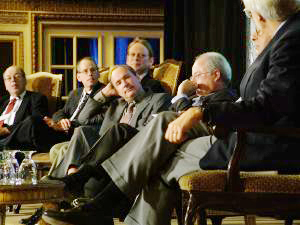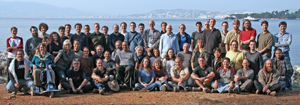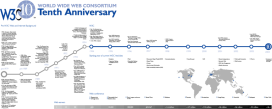Facts About W3C
- On this page →
- people of W3C •
- organizational structure •
- revenue model •
- international participation •
- process •
- patent policy •
- history
The World Wide Web Consortium achieves its mission by bringing diverse stake-holders together, under a clear and effective consensus-based process to develop high-quality standards based on contributions from the W3C Members, staff, and the community at large.
People of W3C
W3C is led by Tim Berners-Lee, inventor of the World Wide Web. As Director, Tim Berners-Lee is supposed by a staff of technical experts who help coordinate technology development and manage the operations of the Consortium.
W3C Members and invited experts from the public provide energy to the groups that write W3C's Web standards.
The broader Web community also plays an important role in reviewing and providing input on specifications; there are many ways to participate in W3C even as an individual.
Organizational Structure
W3C does not have a typical organizational structure, nor is it incorporated. There are at least two ways to think about how W3C is organized:
- in administrative terms
- in process terms
In administrative terms: W3C is administered via a joint agreement among three "Host Institutions" ( MIT , ERCIM , and Keio University). The W3C staff (many of whom work physically at one of these institutions) is led by a Director and CEO. A small management team is responsible for resource allocation and strategic planning on behalf of the staff.Regional offices play an important role in W3C being an international organization.
In process terms: the W3C Process Document, Member Agreement, Patent Policy, and a few others documents establish the roles and responsibilities of the parties involved in the making of W3C standards. Some key components of the organization are:
- the Advisory Committee, composed of one representative from each W3C Member. The Advisory Committee has a number of review roles in the W3C Process, and they elect the Advisory Board and TAG.
- the Advisory Board, an advisory body elected by the Advisory Committee
- the Technical Architecture Group (TAG), which primarily seeks to document Web Architecture principles
- the W3C Director and CEO, who assess consensus for W3C-wide decisions
- the chartered groups, populated by Member representatives and invited experts, and which produce most of W3C's deliverables according to the steps of the W3C Process.
Revenue Model
W3C sources of revenue include:
- W3C Member dues
- Research grants and other sources of private and public funding
- Individual donations of money and equipment through the W3C Supporters Program and the Validator Donation Program
International Participation
Organizations located all over the world and involved in many different fields join W3C to participate in a vendor-neutral forum for the creation of Web standards. W3C Members and a dedicated full-time staff of technical experts have earned W3C international recognition for its contributions to the Web. W3C's global efforts includes:
- liaisons with national, regional and international organizations around the globe. These contacts help W3C maintain a culture of global participation in the development of the World Wide Web. W3C coordinates particularly closely with other organizations that are developing standards for the Web or Internet in order to enable clear progress.
- The Offices Program, which promotes adoption of W3C recommendations among developers, application builders, and standards setters, and encourage inclusions of stakeholder organizations in the creation of future standards by joining W3C.
- translations of Web standards and other materials from dedicated volunteers in the W3C community. W3C also has a policy for authorized translations of W3C materials. Authorized W3C Translations can be used for official purposes in languages other than English.
- talks around the world in a variety of languages on Web standards by people closely involved in the creation of the standards.
- W3C's Internationalization Activity helps ensure that the Web is available to people.
Process
Most W3C work revolves around the standardization of Web technologies. To accomplish this work, W3C follows processes that promote the development of high-quality standards based on community consensus; an introduction to the W3C Process gives a sense of how W3C gets work done. All stakeholders can have a voice in the development of W3C standards, including Members large and small, as well as the public. W3C processes promote fairness, responsiveness, and progress: all facets of the W3C mission.
See also W3C legal and policy information.
Patent Policy
In February 2004, W3C adopted a Patent Policy to enable continued innovation and widespread adoption of Web standards developed by the World Wide Web Consortium. The W3C Patent Policy is designed to:
- Facilitate the development of W3C Recommendations by W3C Working Groups;
- Promote the widespread implementation of those Recommendations on a Royalty-Free (RF) basis;
- Address issues related to patents that arise during and after the development of a Recommendation.
More resources
- Patent Policy FAQ
- Fact Sheet (who has made commitments for the standards created under the policy)
- Policy Summary
- Business Benefits
History
In 1989, Tim Berners-Lee invented the World Wide Web (see the original proposal). He coined the term "World Wide Web," wrote the first World Wide Web server, "httpd," and the first client program (a browser and editor), "WorldWideWeb," in October 1990. He wrote the first version of the "HyperText Markup Language" (HTML), the document formatting language with the capability for hypertext links that became the primary publishing format for the Web. His initial specifications for URIs, HTTP, and HTML were refined and discussed in larger circles as Web technology spread.

W3C10 panel recounts early Web history.
In October 1994, Tim Berners-Lee founded the World Wide Web Consortium (W3C) at the Massachusetts Institute of Technology, Laboratory for Computer Science [MIT/LCS] in collaboration with CERN, where the Web originated (see information on the original CERN Server), with support from DARPA and the European Commission. In April 1995, INRIA (Institut National de Recherche en Informatique et Automatique) became the first European W3C host, followed by Keio University of Japan (Shonan Fujisawa Campus) in Asia in 1996. In 2003, ERCIM (European Research Consortium in Informatics and Mathematics) took over the role of European W3C Host from INRIA.
More history resources
W3C10 Time Line Graphic
(other formats and description)



